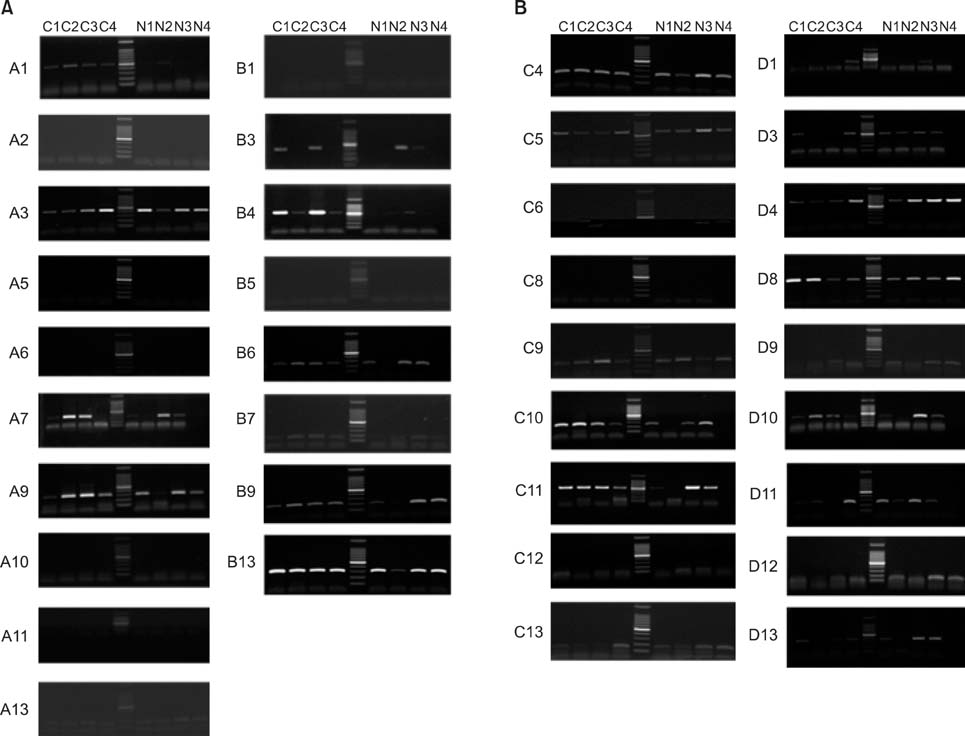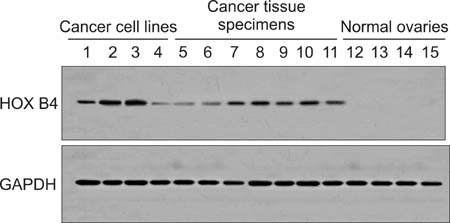J Gynecol Oncol.
2010 Mar;21(1):29-37. 10.3802/jgo.2010.21.1.29.
Expression pattern of the class I homeobox genes in ovarian carcinoma
- Affiliations
-
- 1Department of Obstetrics and Gynecology, Korea University College of Medicine, Seoul, Korea. jhblue5@naver.com
- 2Department of Physiology, Korea University College of Medicine, Seoul, Korea.
- KMID: 2173508
- DOI: http://doi.org/10.3802/jgo.2010.21.1.29
Abstract
OBJECTIVE
Although some sporadic reports reveal the link between the homeobox (HOX) genes and ovarian carcinoma, there is no comprehensive analysis of the expression pattern of the class I homeobox genes in ovarian carcinoma that determines the candidate genes involved in ovarian carcinogenesis. METHODS: The different patterns of expression of 36 HOX genes were analyzed, including 4 ovarian cancer cell lines and 4 normal ovarian tissues. Using a reverse transcription-polymerase chain reaction (RT-PCR) and quantification analysis, the specific gene that showed a significantly higher expression in ovarian cancer cell lines than in normal ovaries was selected, and western blot analysis was performed adding 7 ovarian cancer tissue specimens. Finally, immunohistochemical and immunocytochemical analyses were performed to compare the pattern of expression of the specific HOX gene between ovarian cancer tissue and normal ovaries. RESULTS: Among 36 genes, 11 genes had a different level of mRNA expression between the cancer cell lines and the normal ovarian tissues. Of the 11 genes, only HOXB4 had a significantly higher level of expression in ovarian cancer cell lines than in normal ovaries (p=0.029). Based on western blot, immunohistochemical, and immunocytochemical analyses, HOXB4 was expressed exclusively in the ovarian cancer cell lines or cancer tissue specimens, but not in the normal ovaries. CONCLUSION: We suggest HOXB4 may be a novel candidate gene involved in ovarian carcinogenesis.
Keyword
MeSH Terms
Figure
Reference
-
1. Kumaran GC, Jayson GC, Clamp AR. Antiangiogenic drugs in ovarian cancer. Br J Cancer. 2009. 100:1–7.2. Feng Q, Deftereos G, Hawes SE, Stern JE, Willner JB, Swisher EM, et al. DNA hypermethylation, Her-2/neu overexpression and p53 mutations in ovarian carcinoma. Gynecol Oncol. 2008. 111:320–329.3. Kurman RJ, Shih IeM. Pathogenesis of ovarian cancer: lessons from morphology and molecular biology and their clinical implications. Int J Gynecol Pathol. 2008. 27:151–160.4. Maehle L, Apold J, Paulsen T, Hagen B, Lovslett K, Fiane B, et al. High risk for ovarian cancer in a prospective series is restricted to BRCA1/2 mutation carriers. Clin Cancer Res. 2008. 14:7569–7573.5. Stuart ET, Gruss P. PAX genes: what's new in developmental biology and cancer? Hum Mol Genet. 1995. 4:1717–1720.6. McGinnis W, Krumlauf R. Homeobox genes and axial patterning. Cell. 1992. 68:283–302.7. Scott MP. Vertebrate homeobox gene nomenclature. Cell. 1992. 71:551–553.8. Davis AP, Witte DP, Hsieh-Li HM, Potter SS, Capecchi MR. Absence of radius and ulna in mice lacking hoxa-11 and hoxd-11. Nature. 1995. 375:791–795.9. Cillo C, Barba P, Freschi G, Bucciarelli G, Magli MC, Boncinelli E. HOX gene expression in normal and neoplastic human kidney. Int J Cancer. 1992. 51:892–897.10. De Vita G, Barba P, Odartchenko N, Givel JC, Freschi G, Bucciarelli G, et al. Expression of homeobox-containing genes in primary and metastatic colorectal cancer. Eur J Cancer. 1993. 29A:887–893.11. Magli MC, Barba P, Celetti A, De Vita G, Cillo C, Boncinelli E. Coordinate regulation of HOX genes in human hematopoietic cells. Proc Natl Acad Sci U S A. 1991. 88:6348–6352.12. Belotti D, Clausse N, Flagiello D, Alami Y, Daukandt M, Deroanne C, et al. Expression and modulation of homeobox genes from cluster B in endothelial cells. Lab Invest. 1998. 78:1291–1299.13. Magli MC, Largman C, Lawrence HJ. Effects of HOX homeobox genes in blood cell differentiation. J Cell Physiol. 1997. 173:168–177.14. Hatano M, Roberts CW, Minden M, Crist WM, Korsmeyer SJ. Deregulation of a homeobox gene, HOX11, by the t(10;14) in T cell leukemia. Science. 1991. 253:79–82.15. Calvo R, West J, Franklin W, Erickson P, Bemis L, Li E, et al. Altered Hox and Wnt7A expression in human lung cancer. Proc Natl Acad Sci U S A. 2000. 97:12776–12781.16. Hung YC, Ueda M, Terai Y, Kumagai K, Ueki K, Kanda K, et al. Homeobox gene expression and mutation in cervical carcinoma cells. Cancer Sci. 2003. 94:437–441.17. Naora H, Yang YQ, Montz FJ, Seidman JD, Kurman RJ, Roden RB. A serologically identified tumor antigen encoded by a homeobox gene promotes growth of ovarian epithelial cells. Proc Natl Acad Sci U S A. 2001. 98:4060–4065.18. Naora H, Montz FJ, Chai CY, Roden RB. Aberrant expression of homeobox gene HOXA7 is associated with mullerian-like differentiation of epithelial ovarian tumors and the generation of a specific autologous antibody response. Proc Natl Acad Sci U S A. 2001. 98:15209–15214.19. Osborne J, Hu C, Hawley C, Underwood LJ, O'Brien TJ, Baker VV. Expression of HOXD10 gene in normal endometrium and endometrial adenocarcinoma. J Soc Gynecol Investig. 1998. 5:277–280.20. Muragaki Y, Mundlos S, Upton J, Olsen BR. Altered growth and branching patterns in synpolydactyly caused by mutations in HOXD13. Science. 1996. 272:548–551.21. Mortlock DP, Innis JW. Mutation of HOXA13 in hand-foot-genital syndrome. Nat Genet. 1997. 15:179–180.22. Vider BZ, Zimber A, Hirsch D, Estlein D, Chastre E, Prevot S, et al. Human colorectal carcinogenesis is associated with deregulation of homeobox gene expression. Biochem Biophys Res Commun. 1997. 232:742–748.23. Cillo C, Barba P, Freschi G, Bucciarelli G, Magli MC, Boncinelli E. HOX gene expression in normal and neoplastic human kidney. Int J Cancer. 1992. 51:892–897.24. Celetti A, Barba P, Cillo C, Rotoli B, Boncinelli E, Magli MC. Characteristic patterns of HOX gene expression in different types of human leukemia. Int J Cancer. 1993. 53:237–244.25. Amsellem S, Pflumio F, Bardinet D, Izac B, Charneau P, Romeo PH, et al. Ex vivo expansion of human hematopoietic stem cells by direct delivery of the HOXB4 homeoprotein. Nat Med. 2003. 9:1423–1427.26. Care A, Felicetti F, Meccia E, Bottero L, Parenza M, Stoppacciaro A, et al. HOXB7: a key factor for tumor-associated angiogenic switch. Cancer Res. 2001. 61:6532–6539.27. Chu MC, Selam FB, Taylor HS. HOXA10 regulates p53 expression and matrigel invasion in human breast cancer cells. Cancer Biol Ther. 2004. 3:568–572.28. Mack JA, Li L, Sato N, Hascall VC, Maytin EV. HOXB13 up-regulates transglutaminase activity and drives terminal differentiation in an epidermal organotypic model. J Biol Chem. 2005. 280:29904–29911.29. Alami Y, Castronovo V, Belotti D, Flagiello D, Clausse N. HOXC5 and HOXC8 expression are selectively turned on in human cervical cancer cells compared to normal keratinocytes. Biochem Biophys Res Commun. 1999. 257:738–745.30. Lopez R, Garrido E, Pina P, Hidalgo A, Lazos M, Ochoa R, et al. HOXB homeobox gene expression in cervical carcinoma. Int J Gynecol Cancer. 2006. 16:329–335.31. Lane DB, Rutherford TJ, Taylor HS. HOXA10 expression in endometrial adenocarcinoma. Tumour Biol. 2004. 25:264–269.32. Zhao Y, Yamashita T, Ishikawa M. Regulation of tumor invasion by HOXB13 gene overexpressed in human endometrial cancer. Oncol Rep. 2005. 13:721–726.33. Lawrence HJ, Rozenfeld S, Cruz C, Matsukuma K, Kwong A, Komuves L, et al. Frequent co-expression of the HOXA9 and MEIS1 homeobox genes in human myeloid leukemias. Leukemia. 1999. 13:1993–1999.34. Zhang XB, Beard BC, Trobridge GD, Wood BL, Sale GE, Sud R, et al. High incidence of leukemia in large animals after stem cell gene therapy with a HOXB4-expressing retroviral vector. J Clin Invest. 2008. 118:1502–1510.35. Bodey B, Bodey B Jr, Siegel SE, Kaiser HE. Immunocytochemical detection of the homeobox B3, B4, and C6 gene products in breast carcinomas. Anticancer Res. 2000. 20:3281–3286.36. Bodey B, Bodey B Jr, Siegel SE, Luck JV, Kaiser HE. Homeobox B3, B4, and C6 gene product expression in osteosarcomas as detected by immunocytochemistry. Anticancer Res. 2000. 20:2717–2721.37. Bodey B, Bodey B Jr, Groger AM, Siegel SE, Kaiser HE. Immunocytochemical detection of the homeobox B3, B4, and C6 gene product expression in lung carcinomas. Anticancer Res. 2000. 20:2711–2716.38. Sellar GC, Watt KP, Li L, Nelkin BD, Rabiasz GJ, Porteous DJ, et al. The homeobox gene BARX2 can modulate cisplatin sensitivity in human epithelial ovarian cancer. Int J Oncol. 2002. 21:929–933.39. Vang R, Gown AM, Wu LS, Barry TS, Wheeler DT, Yemelyanova A, et al. Immunohistochemical expression of CDX2 in primary ovarian mucinous tumors and metastatic mucinous carcinomas involving the ovary: comparison with CK20 and correlation with coordinate expression of CK7. Mod Pathol. 2006. 19:1421–1428.40. Bowen NJ, Logani S, Dickerson EB, Kapa LB, Akhtar M, Benigno BB, et al. Emerging roles for PAX8 in ovarian cancer and endosalpingeal development. Gynecol Oncol. 2007. 104:331–337.
- Full Text Links
- Actions
-
Cited
- CITED
-
- Close
- Share
- Similar articles
-
- Rhox in mammalian reproduction and development
- Anticancer Effect and Apoptosis of All-trans-retinoic Acid on the Human Ovarian Epithelial Carcinoma Cell Lines
- A Study on Expression Pattern of p53, Rb Gene and Apoptosis in Ovarian Epithelial Borderline Tumors and Invasive Carcinoma
- Expression of p53, p16, PTEN, and c-myc Gene with Cisplatin Treatment in Cisplatin Resistant Ovarian Cancer Cell Line
- Nuclear localization of Obox4 is dependent on its homeobox domain






